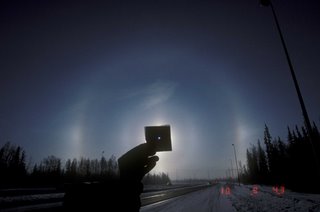In the evening, I looked at meteoblue's meteogram (like I do everyday), and saw on it plenty of high-level clouds, but at the same time together with middle-level clouds. At 09-30 I woke up that to check whether middle clouds would not allow observing halos.
I came out and saw that the sky indeed was pretty dirty and contained not only cirrus but also low and middle clouds. But above the sun were the central part of UTA and diffuse pillar. I could leisurely to prepare my camera before halos became brighter.
After a few minutes, UTA became seen pretty well. Viewing the sky I was very surprised to detect the supralateral arc to the left of the sun. The arc was not bright but it was clearly visible. It was weird to see such good halos in such dense clouds. Clouds from different levels merged with each other. So at first, I did not understand that it was a big display that penetrated through the gaps of the lower clouds.
After 10-15 minutes came a big gap in those clouds and I saw the full Supralateral arc which was noticeably brighter than previously. I already was very glad because the arc in this form I saw only on my screen when I processed stacks. And at the moment I saw it in the sky with my own eyes. However, this was only a prelude of what was to come.
 |
| Wegener arc, subhelic arc, and blue spot on parhelic circle |
 |
|
 |
|
Around 11-00 the sky started to clear and above the supralateral arc and a nice circumzenithal arc appeared. In that moment I noticed to the west a bright fragment of the parhelic circle which was low over trees. Cirrus arrived from this direction. While I changed the direction of my camera's field of view, I noticed also the anthelion. High clouds arrived quickly, and they were very uniform and smooth. The brightness of halos quick started to accrue. I ran in my home in order to show the current display to my father, and during this couple of minutes the brightness of halos increased even more. I ran back to my camera, and in this moment halos became extremely bright! The upper tangent arc was very perfect and sharp. The supralateral arc was brighter than a common primary rainbow! Probably it reached such extreme brightness not only because crystals were perfect, but also because the sun elevation was almost optimal. The parhelic circle was also incredible and looked like jets of light. Wegener arc was visually visible as well. Its oblique wide lines pointed out on far and weak anthelion. Around anthelion from time to time X-shaped arc was visible.
 |
| Near sun there are 9° halo together 9° column arcs |
 |
| All sky view. Near anthelion there is Tricker arc |
 |
| Anthelion and some of diffuse anthelic arcs |
 |
| Upper tangent arc with diffuse upper 23° plate arc and sharp 24° column arcs. Thanks to M.Riikonen for the confirmation |
|
Halos lasted in this bright form around 45 minutes. After the brightness of complex a few decreased, but all details continued were visually visible. I remember that I saw well crossing of Supra/Infra-lateral arcs on the parhelic circle. Also from time to time appeared 120° parhelia.
 |
| On the left there is 120° parhelion |
At 13-10 was the end of this great display, only halos near the sun remained. Parhelia were most bright in this moment and seemed to me that near them were Lowitz arcs. But stacks showed that is not true.











